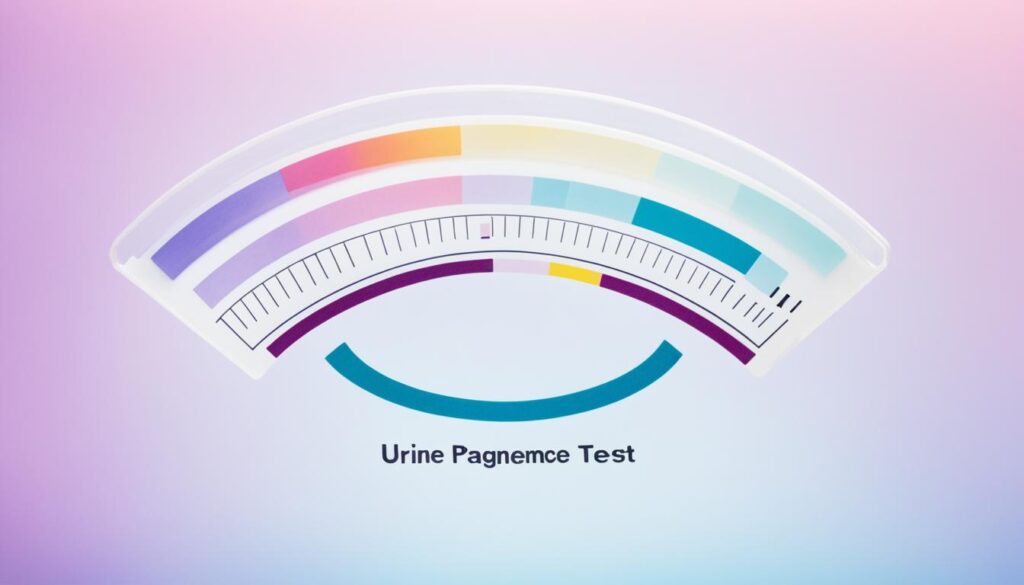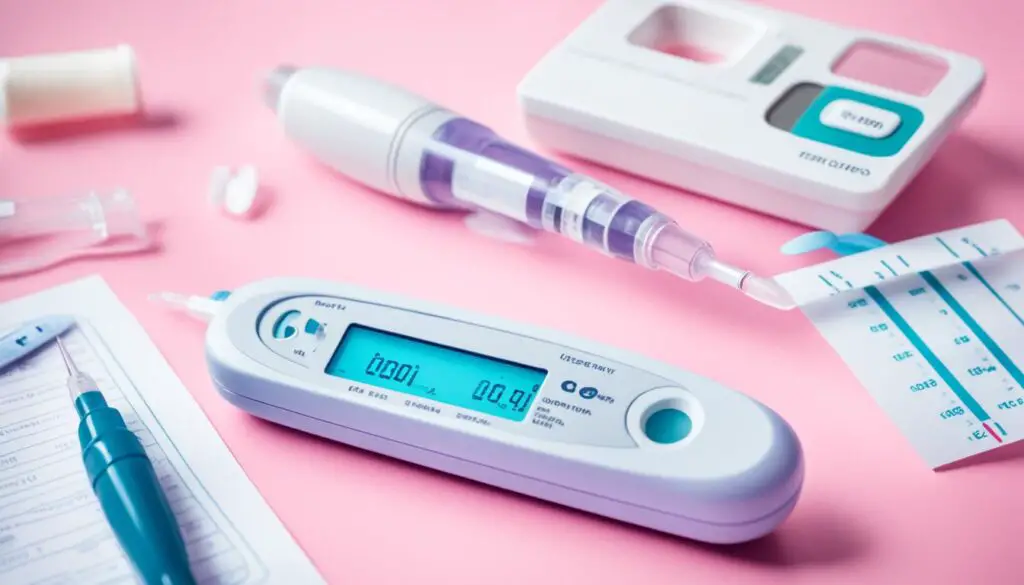Did you know that monitoring human chorionic gonadotropin (HCG) levels during pregnancy can provide crucial insights into the health and progression of the pregnancy? HCG levels play a vital role in confirming pregnancy, detecting potential issues, and ensuring the well-being of both the mother and the baby.
Whether you are a healthcare professional or an expectant mother, understanding how to track HCG levels effectively is essential. By monitoring these levels accurately and employing best practices, you can gain valuable information about the development of the pregnancy and take proactive measures when necessary.
Key Takeaways:
- Tracking HCG levels during pregnancy provides crucial insights into the health and progression of the pregnancy.
- HCG levels play a vital role in confirming pregnancy, detecting potential issues, and ensuring the well-being of both the mother and the baby.
- By monitoring HCG levels accurately and employing best practices, you can gain valuable information about the development of the pregnancy.
- Understanding how to track HCG levels effectively is essential for healthcare professionals and expectant mothers alike.
- Take proactive measures based on HCG level trends to ensure the best possible outcome for both mother and baby.
Uses of the hCG Urine Test
The hCG urine test serves as a valuable tool in confirming pregnancy. By detecting the presence of hCG in the urine, this test provides a positive indication of pregnancy. However, it is important to note that the hCG urine test is qualitative in nature, meaning it does not provide specific levels of the hormone. Instead, its primary purpose lies in confirming whether or not a pregnancy is present.
As a pregnancy confirmation test, the hCG urine test is not intended to diagnose or monitor the progress of a pregnancy. Its usefulness lies in its ability to provide a reliable indication of pregnancy at an early stage, with the ability to detect hCG in the urine approximately one day after a missed period. This makes it an accessible and convenient option for individuals who suspect they may be pregnant.
It is worth noting that while the hCG urine test is highly accurate, there is a possibility of false-positive or false-negative results. Factors such as taking the test too early, using diluted urine, or errors in the test procedure can contribute to inaccurate results. Therefore, it is vital to carefully read and follow the instructions provided with the test kit in order to achieve the most accurate results.
Ultimately, the hCG urine test serves as an important tool in the early stages of pregnancy confirmation. Its ease of use, accessibility, and reliable indication of pregnancy make it a popular choice for individuals seeking confirmation. However, in cases of uncertainty or abnormal results, it is important to consult a healthcare professional for further guidance and follow-up testing.
Next, we will explore the risks associated with the hCG urine test and the necessary preparations for accurate testing.
Risks and Preparations for the hCG Urine Test

The hCG urine test, while commonly used for pregnancy confirmation, carries certain risks, including the possibility of false-positive or false-negative results.
A false-positive result occurs when the test indicates a pregnancy when there isn’t one. On the other hand, a false-negative result suggests no pregnancy when, in reality, there is. False-negative results are more common, especially in the early stages of pregnancy or if the urine is too diluted to detect hCG.
In the event of abnormal results, such as detecting non-pregnancy tissue or experiencing a negative result despite being pregnant, it is recommended to seek follow-up by a healthcare professional. Additional testing or evaluation may be required to determine the accuracy and potential underlying causes of these abnormal results.
Proper preparations are essential for accurate test results. It is crucial to carefully read and follow the instructions provided with the test kit. Using the first-morning urine after the first missed period is ideal, as it generally contains a higher concentration of hCG. Additionally, it is advisable to avoid excessive fluid intake before collecting the urine sample to prevent dilution and potential false-negative results.
Quotes:
“The main risks associated with the hCG urine test are false-positive or false-negative results.”
“False-negative results are more common, especially in early pregnancy or if the urine is too diluted to detect hCG.”
Preparations for the hCG Urine Test:
- Read and follow the instructions provided with the test kit
- Use the first-morning urine after the first missed period
- Avoid excessive fluid intake before collecting the urine sample
| Risks | Preparations |
|---|---|
| False-positive or false-negative results | Read and follow the instructions provided with the test kit |
| More common false-negative results, especially in early pregnancy or diluted urine | Use the first-morning urine after the first missed period and avoid excessive fluid intake |
Performing the hCG Urine Test
Performing the hCG urine test is a straightforward process that can be done in the comfort of your own home or with the guidance of a healthcare professional. Regardless of where you choose to take the test, the key is to collect a urine sample for analysis. Following the provided instructions with the test kit is crucial to ensure accurate results.
For at-home tests:
- Start by thoroughly washing your hands and ensuring a clean testing environment.
- Hold the indicator stick in the urine stream or collect urine in a cup.
- If using the urine stream method, carefully hold the stick so that the absorbent tip is exposed to the urine for the specified duration provided by the manufacturer.
- If using a cup, dip the indicator stick into the urine sample, making sure to immerse the absorbent tip completely.
- Ensure the stick is not left in the urine for longer or shorter than the instructed time, as this may affect the accuracy of the results.
- Place the indicator stick on a clean, dry surface and wait for the designated time period.
- After the waiting period, check the results based on the presence or absence of a colored line or symbol.
For healthcare professional-assisted tests:
- Visit a healthcare provider’s office or clinic where the test will be conducted.
- Follow any specific instructions given by the healthcare professional.
- Provide a urine sample as directed.
- The healthcare professional may perform the analysis immediately or send the sample to a laboratory for testing.
- A healthcare professional will interpret the results and provide guidance based on the findings.
Most hCG urine tests provide results within 5 to 10 minutes. A positive result indicates the presence of hCG and, in most cases, indicates pregnancy. Conversely, a negative result suggests the absence of hCG. It is important to remember that while hCG urine tests are convenient and widely accessible, they are qualitative tests and not a definitive diagnosis of pregnancy. For confirmation or if there is uncertainty surrounding the results, consulting with a healthcare professional is recommended for further testing or guidance.
Interpreting the Results of the hCG Urine Test

When it comes to interpreting the results of the hCG urine test, following the instructions correctly is crucial for accuracy. Negative results may be uncertain, especially if the test was taken too early or the timing of the missed period was miscalculated, and could indicate a false negative. In such cases, it is recommended to repeat the test in about a week to confirm the absence of pregnancy.
If you have concerns that the test results are inaccurate or conflicting, it is important to consult a healthcare professional for further guidance. They can provide the necessary expertise and advice to help you understand and interpret the results correctly.
On the other hand, a positive result on the hCG urine test indicates the detection of hCG hormone in the urine, which is a strong indication of pregnancy. However, it is important to note that a positive result on the urine test should still be followed up with confirmation from a doctor, typically through a blood test.
False-Negative Results
False-negative results are more common in early pregnancy or if the urine is too diluted to detect hCG. It is recommended to repeat the test after a few days to a week if you suspect a false negative. The concentration of hCG in the urine increases rapidly in the first few weeks of pregnancy, so waiting a bit longer before taking the test again can increase the chances of obtaining an accurate result.
Furthermore, it’s important to note that false-negative results can also occur if the test is taken too early, before the hCG hormone has had enough time to build up in the body. Waiting until after the first missed period can increase the accuracy of the test results.
False-Positive Results
While less common, false-positive results can also occur on the hCG urine test. A false-positive result indicates a pregnancy when there isn’t one. This can happen due to factors such as the presence of certain medications or medical conditions that can interfere with the test results.
If you receive a positive result on the urine test but are unsure or suspicious about its accuracy, it is important to consult a healthcare professional for further evaluation and confirmation.
Confirming Pregnancy with a Blood Test
A blood test is the most accurate method for confirming pregnancy. It can measure the exact amount of hCG present in the blood and provide a more precise assessment of pregnancy status. If you have received a positive result on the hCG urine test, your healthcare provider may recommend a blood test to confirm the pregnancy and monitor the hCG levels more closely.
Keep in mind that while the hCG urine test provides a reliable initial indication of pregnancy, a blood test is often necessary to confirm the results and establish a baseline for the hCG levels.
“The accuracy of hCG urine test results depends on following the instructions correctly.”
“Negative results may be uncertain and could indicate a false negative, especially if the test was taken too early or the timing of the missed period was miscalculated.”
“A positive result indicates the detection of hCG in the urine and should be followed up with confirmation from a doctor, typically through a blood test.”
| Result | Meaning |
|---|---|
| Positive | Pregnancy is likely |
| Negative | Pregnancy is unlikely, but repeat test after a few days to a week to confirm |
How Pregnancy Tests Work
Pregnancy tests work by detecting the presence of hCG in the body, a hormone that is produced during pregnancy. This hormone can be found in both urine and blood, making these two types of tests the most common methods for detecting pregnancy.
Urine tests, also known as home pregnancy tests, are widely available and can be conveniently done in the comfort of your own home. These tests utilize reactive paper strips that are specially designed to detect hCG in urine. When the urine comes into contact with the reactive strips, it triggers a chemical reaction that produces a visible result. This result can be displayed in various ways, such as a plus sign or specific symbols, indicating a positive result.
Blood tests, on the other hand, are typically performed by healthcare providers and offer more precise measurements of hCG levels. These tests can determine the exact amount of hCG present in the blood, which can be useful in certain medical situations. Blood tests are generally more sensitive than urine tests and can detect lower levels of hCG, making them a valuable tool in detecting early pregnancies or monitoring hCG levels in high-risk pregnancies.
There are different types of pregnancy tests available, including both urine and blood tests. The choice between the two depends on various factors, such as convenience, cost, and the level of accuracy required. Urine tests are the most commonly used tests due to their ease of use and affordability, while blood tests provide quantitative data and are often used in specific medical situations.
Detection of hCG in Urine vs. Blood Tests
Urine tests detect the presence of hCG in the urine, indicating a positive result for pregnancy. These tests are qualitative, meaning they provide a yes or no answer regarding the presence of hCG. On the other hand, blood tests can measure the exact levels of hCG in the blood, providing more quantitative data. Blood tests can be further classified into two types: qualitative blood tests, which confirm the presence of hCG, and quantitative blood tests, which measure the exact amount of hCG in the blood. Quantitative blood tests are often used in medical settings to monitor hCG levels throughout pregnancy or to diagnose certain conditions.
It’s important to note that both urine and blood tests are highly accurate when used correctly. However, it’s essential to carefully follow the instructions provided with the test kits to ensure reliable results. Additionally, false negatives and false positives can occur with both types of tests, so it’s always recommended to consult a healthcare professional for further confirmation if there is any doubt regarding the test results.
| Urine Tests | Blood Tests |
|---|---|
| Can be done at home or in a healthcare provider’s office | Usually performed by a healthcare provider |
| Qualitative results: yes or no answer regarding the presence of hCG | Can provide both qualitative and quantitative results |
| Less sensitive than blood tests | More sensitive than urine tests |
| Can detect pregnancy about a day after the first missed period | Can detect pregnancy earlier than urine tests |
| Affordable and widely available | More expensive and usually performed in medical settings |
Overall, pregnancy tests are an effective and accessible tool for detecting the presence of hCG and confirming pregnancy. Whether you choose a urine test or a blood test, it’s essential to follow the instructions carefully and consult a healthcare professional for further guidance and confirmation if needed.
Different Types of Pregnancy Tests

When it comes to determining whether you’re pregnant or not, there are two main types of tests that you can choose from: urine tests and blood tests.
At-home pregnancy tests, also known as urine tests, are widely available in most drug or grocery stores. These tests use urine to detect the presence of the hormone hCG, which is an indicator of pregnancy. At-home pregnancy tests are affordable, easy to use, and when used correctly, can be about 99% effective.
Performing an at-home pregnancy test is simple. You can collect a urine sample in a cup and either place drops of urine on a chemical strip, dip the test strip into the urine, or hold the strip in the urine stream. Follow the instructions provided with the test kit for accurate testing. Results are typically available within a few minutes and are indicated by the presence or absence of a colored line or symbol.
“At-home pregnancy tests provide a convenient and affordable option for women who want to test for pregnancy in the privacy of their own homes.”
Blood tests, on the other hand, are performed by healthcare providers and offer a more precise measurement of hCG levels. These tests can determine the exact amount of hCG present in the blood, providing a more accurate assessment of pregnancy. However, blood tests are typically reserved for specific situations where more detailed information is needed.
A blood test for pregnancy is performed by drawing a blood sample from your arm and sending it to a laboratory for analysis. This type of test is usually recommended if there is a need to monitor hCG levels closely or if there are concerns about the accuracy of a urine test result.
Comparison of Different Types of Pregnancy Tests:
| Aspect | At-home Pregnancy Test (Urine Test) | Blood Pregnancy Test |
|---|---|---|
| Availability | Widely available in drug or grocery stores | Performed by healthcare providers |
| Cost | Inexpensive | May be covered by insurance, cost varies |
| Accuracy | About 99% effective when used correctly | More precise measurement of hCG levels |
| Procedure | Urine sample collection; test strip method | Blood sample collection; laboratory analysis |
Both at-home pregnancy tests and blood tests have their own advantages and considerations. At-home tests offer convenience, affordability, and quick results, making them the go-to option for most women. On the other hand, blood tests provide more accurate measurements of hCG levels and are recommended in specific situations or when there is a need for more detailed information.
In the next section, we will delve deeper into understanding hCG levels in pregnancy and their significance.
Advantages of Using a Home Pregnancy Test

When it comes to confirming pregnancy, home pregnancy tests offer a range of advantages that make them a popular choice for individuals seeking quick and reliable results. These tests are designed to be affordable, easy to use, and provide fast results, ensuring convenience and peace of mind.
One of the key benefits of home pregnancy tests is their affordability. Most at-home tests are readily available at drugstores or grocery stores and are priced competitively. This makes them accessible to a wide range of individuals who may be looking for an inexpensive pregnancy test option.
In addition to being affordable, home pregnancy tests are also incredibly user-friendly. They typically come with clear instructions that guide users throughout the testing process. Additionally, these tests can be performed in the privacy of one’s own home, offering individuals the comfort and convenience of conducting the test at their own pace.
“Home pregnancy tests offer several advantages, including affordability, ease of use, and quick results.”
When it comes to getting results quickly, home pregnancy tests deliver. Most at-home tests are designed to provide results within just a few minutes. This quick turnaround time allows individuals to promptly receive information about their pregnancy status, reducing anxiety and uncertainty.
It’s important to note that home pregnancy tests are highly accurate when used correctly. These tests have an accuracy rate of about 98% to 99%, providing individuals with reliable results. However, for optimal accuracy, it’s crucial to carefully follow the instructions provided with the test kit.
In summary, home pregnancy tests offer several advantages, including affordability, ease of use, and quick results. These tests provide a convenient and accessible option for individuals who want to test for pregnancy in the comfort and privacy of their own homes. With their reliable accuracy and fast turnaround time, home pregnancy tests are a valuable tool in confirming pregnancy.
Understanding HCG Levels in Pregnancy

HCG levels in pregnancy provide valuable insights into the progress of the pregnancy. By monitoring hCG levels, doctors can detect potential concerns and ensure the well-being of both the mother and the baby. Understanding the patterns and trends in hCG levels can help expectant parents navigate this exciting journey with knowledge and confidence.
During the early stages of pregnancy, hCG levels increase gradually. This increase is driven by the developing placenta, which secretes hCG into the bloodstream. Typically, hCG levels peak around 8-10 weeks after implantation and then begin to plateau. Eventually, hCG levels start declining, as the placenta becomes more established and takes over the production of other hormones.
It’s important to note that while specific hCG numbers vary widely, doctors pay more attention to trends rather than absolute values. Falling, plateauing, or abnormally slow-rising hCG levels may indicate a potential concern, such as a miscarriage or ectopic pregnancy. On the other hand, extremely high hCG levels may suggest a placental tumor or a pregnancy with multiples.
However, once a pregnancy is confirmed through an ultrasound, hCG levels are not typically monitored as closely. Other indicators, such as uterine size and the presence of fetal heart sounds, become more important in assessing the progress of the pregnancy.
Normal hCG Levels in Pregnancy
While there is a wide range of normal hCG levels in pregnancy, here are some general guidelines:
| Weeks from Last Menstrual Period (LMP) | Average hCG level (mIU/mL) |
|---|---|
| 3 weeks LMP | 5 – 50 mIU/mL |
| 4 weeks LMP | 5 – 426 mIU/mL |
| 5 weeks LMP | 18 – 7,340 mIU/mL |
| 6 weeks LMP | 1,080 – 56,500 mIU/mL |
| 7 – 8 weeks LMP | 7,650 – 229,000 mIU/mL |
| 9 – 12 weeks LMP | 25,700 – 288,000 mIU/mL |
| 13 – 16 weeks LMP | 13,300 – 254,000 mIU/mL |
| 17 – 24 weeks LMP | 4,060 – 165,400 mIU/mL |
| 25 – 40 weeks LMP | 3,640 – 117,000 mIU/mL |
Keep in mind that these values are only average ranges, and individual hCG levels can vary. It’s essential to consult with a healthcare professional to interpret hCG levels accurately and in the context of individual circumstances.
Monitoring hCG Levels
Monitoring hCG levels in early pregnancy can provide valuable information about the health and progress of the pregnancy. If there are concerns or risk factors, such as a history of miscarriage or infertility treatments, doctors may recommend more frequent hCG level measurements to ensure a healthy outcome.
It’s important to remember that hCG levels alone are not definitive evidence of a successful pregnancy. They are just one piece of the puzzle. Other factors, such as ultrasounds and physical examinations, contribute to the overall assessment of the pregnancy. Additionally, hCG levels vary naturally between individuals, so comparing hCG levels between different pregnancies may not yield meaningful information.
Understanding hCG levels in pregnancy allows expectant parents to have informed discussions with their healthcare providers and make the best decisions for their unique situations. By partnering with medical professionals and staying informed, parents-to-be can navigate the journey of pregnancy with confidence and peace of mind.
Conclusion
In summary, tracking HCG levels during pregnancy is crucial for confirming pregnancy and monitoring its progress. The hCG urine test plays a significant role in this process, providing a qualitative result. To ensure accurate testing, it is essential to carefully follow the instructions provided with the test kit.
Interpreting the results of the hCG urine test helps determine the presence and progress of pregnancy. In case of uncertain results, it is recommended to seek further testing or consult with a healthcare professional. Home pregnancy tests offer convenience and affordability, while blood tests provide more precise measurements of hCG levels.
Monitoring hCG levels during the early stages of pregnancy can help detect potential issues. However, after confirmation of a healthy pregnancy, other indicators such as uterine size become more important in assessing the progress of the pregnancy. Understanding the significance of hCG level tracking and utilizing appropriate testing methods can contribute to a successful and healthy pregnancy journey.
FAQ
How do I track HCG levels effectively?
Tracking HCG levels effectively can be done through the use of urine tests, which detect the presence of HCG in the body. These tests are available at home or at a doctor’s office and provide qualitative results indicating pregnancy or the absence of it.
What are the uses of the hCG urine test?
The hCG urine test is primarily used as a pregnancy confirmation test. It detects the presence of hCG in the urine, which is considered a positive sign of pregnancy. The test is qualitative and does not provide specific levels of the hormone.
What are the risks and preparations for the hCG urine test?
Risks associated with the hCG urine test include false-positive or false-negative results. Preparations for the test include carefully reading and following the instructions provided with the test kit, using the first-morning urine after the first missed period, and avoiding excessive fluid intake before collecting the urine sample.
How do I perform the hCG urine test at home?
The procedure for performing the hCG urine test at home typically involves holding the indicator stick in the urine stream or collecting urine in a cup and then dipping the indicator stick. It is important to follow the instructions provided with the test kit for accurate testing.
How do I interpret the results of the hCG urine test?
The hCG urine test provides qualitative results indicating pregnancy or the absence of it. False-negative results are more common, especially in early pregnancy or if the urine is too diluted to detect hCG. If there is concern about the accuracy of the test results, consulting a healthcare professional is advised.
How do pregnancy tests work?
Pregnancy tests work by detecting the presence of hCG in the body, which can be found in urine or blood. Urine tests use reactive paper strips to detect hCG, while blood tests can measure the exact amount of hCG present in the blood.
What are the different types of pregnancy tests?
There are two main types of pregnancy tests: urine tests and blood tests. Urine tests can be done at home or at a healthcare provider’s office, while blood tests are usually performed by a healthcare provider.
What are the advantages of using a home pregnancy test?
Home pregnancy tests offer several advantages, including affordability, ease of use, and quick results. They are about 98% to 99% accurate when used correctly and provide results within a few minutes.
How can I understand HCG levels in pregnancy?
HCG levels in pregnancy typically increase steadily in the first few weeks and peak around 8-10 weeks after implantation. Monitoring hCG levels can help detect potential issues, but after confirmation of a healthy pregnancy, other indicators become more important in assessing the progress of the pregnancy.
What is the conclusion of HCG level tracking?
Tracking HCG levels during early pregnancy can be done through urine tests, which confirm pregnancy and provide qualitative results. Monitoring hCG levels can help detect potential issues, but after confirmation of a healthy pregnancy, other indicators become more important in assessing the progress of the pregnancy.




